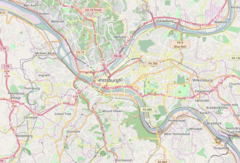Allegheny Arsenal

The 40th Street side of the site of the former Allegheny Arsenal. The powder magazine can be seen on the right.
|
|
| Location | Arsenal Park, Lawrenceville, Pittsburgh, Pennsylvania |
|---|---|
| Coordinates | 40°28′00″N 79°57′40″W / 40.4666°N 79.9611°W |
| Area | 9 acres (3.6 ha) |
| Built/founded | 1814 |
| Architect | Benjamin Henry Latrobe? |
| Governing body/ |
City of Pittsburgh |
| PA marker dedicated | n/a |
| City designated | February 22, 1977 |
| PHLF designated | 2003 |
The Allegheny Arsenal, established in 1814, was an important supply and manufacturing center for the Union Army during the American Civil War, and the site of the single largest civilian disaster during the war.
Today, the site is the location of the nine-acreArsenal Park in the Central Lawrenceville neighborhood of Pittsburgh, Pennsylvania.
In 2012, officials from the Pittsburgh History & Landmarks Foundation began drawing attention to the deteriorating arsenal structures.
The Arsenal was established by the U.S. Army Ordnance Department near Pittsburgh in 1814. It was situated on 30 acres (12 ha) of land bordering the Allegheny River in the community of Lawrenceville.
The arsenal served as a supply and manufacturing center for the troops in the west. Its peak years came during the Civil War, especially when the manufacture of cartridges, became a high priority. Civilian employment at the arsenal increased from a pre-war total of 308 to over 1100 workers. One of the busiest facilities was the main lab, which employed 158 workers, the majority of whom were women engaged in the making of cartridges.
On Wednesday, September 17, 1862, around 2 pm, the arsenal exploded. The explosion shattered windows in the surrounding community and was heard in Pittsburgh, over two miles (3 km) away. At the sound of the first explosion, Col. John Symington, Commander of the Arsenal, rushed from his quarters and made his way up the hillside to the lab. As he approached, he heard the sound of a second explosion, followed by a third. Fire fighting equipment as well as a bucket brigade tried to douse the flames with water. The volunteer fire company from Pittsburgh arrived and assisted in bringing the fire under control.
By the time the fire was put out, the lab had been reduced to a pile of smoldering rubble. 78 workers, mostly young women, were killed. 54 bodies were unidentified, and were buried in a mass grave in the nearby Allegheny Cemetery. Among those killed were 15-year-old munitions assembler Catherine Burkhart, who lived at 184 38th Street.
...
Wikipedia

